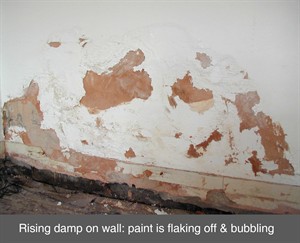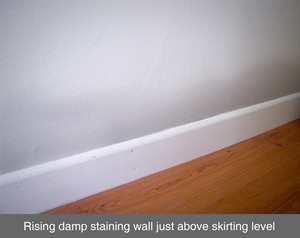Rising Damp
 Damp within our homes and buildings can
generally be classified into 3 types (rising damp, penetrating damp
& condensation), each of which has a distinct solution; it is
therefore imperative that one of our experienced surveyors carries
out a full survey of the property prior to any remedial works being
carried out.
Damp within our homes and buildings can
generally be classified into 3 types (rising damp, penetrating damp
& condensation), each of which has a distinct solution; it is
therefore imperative that one of our experienced surveyors carries
out a full survey of the property prior to any remedial works being
carried out.
It is important to note that leaking pipes can also cause damp;
our experienced surveyors are adept at identifying the root cause
of the problem.
Rising Damp
Rising damp only affects ground floor walls. If the damp
problem is at first floor, or above, then it is possible that the
cause is condensation or penetrating damp.

Signs of rising damp include:
- horizontal 'tidemarks', generally less than 1m in height, where
the wall is discoloured, with general darkening and
patchiness;
- white effloresence, loose wallpaper, and deterioration to
plaster;
- signs of skirting boards deteriorating or rotting.
Common Causes of Rising Damp
Rising damp is caused by the capillary action of water being
drawn up into porous masonry from wet ground. Masonry naturally
acts like a sponge, soaking up water that exists in the
ground. New buildings will have a damp proof membrane,
however, older, solid walls are unlikely to have this. Common
causes of rising damp are:
- absence of a damp proof course, common in older buildings,
- the bridging of the damp proof course; eg either in the
cavity by mortar, or externally by rubbish or soil piled up against
the outside of the wall
Rising Damp is generally treated by one of three methods: Electro-Osmosis DPC, Chemical
Injection DPC, or Newlath Damp Proof
Membrane. Our trained surveyors will carry out a detailed
survey and can advise on the best solution. We provide
an insurance
backed guarantee for all remedial damp works carried out.